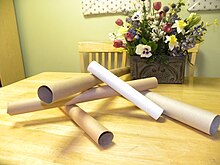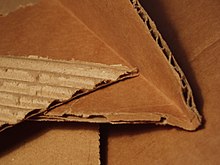Cardboard
Natural cardboards can range from grey to light brown in color, depending on the specific product; dyes, pigments, printing, and coatings are available.
The word cardboard has general use in English and French,[1][2] but the term is deprecated in commerce and industry as not adequately defining a specific product.
[7] In the same year, over 13,000 separate pieces of consumer cardboard packaging were thrown away by American households, combined with all paper products, and this constitutes almost 42 percent of all solid waste generated by the United States annually.
In an effort to reduce this environmental impact, many households have started repurposing cardboard boxes for eco-friendly purposes.
[13] The Kellogg brothers first used paperboard cartons to hold their flaked corn cereal, and later, when they began marketing it to the general public, a heat-sealed bag of wax paper was wrapped around the outside of the box and printed with their brand name.




